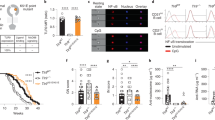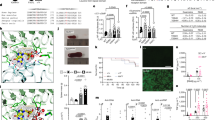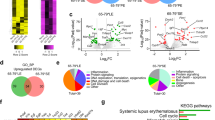Abstract
Genetic analyses of the lupus-prone NZM2410 mouse have identified multiple susceptibility loci on chromosome 7, termed Sle3 and Sle5. Both of these loci were contained within a large congenic interval, originally termed as Sle3 that strongly impacts a variety of myeloid and T-cell phenotypes and mediates fatal lupus nephritis when combined with Sle1. We have now produced two subcongenic strains, B6.Sle3 and B6.Sle5, carrying the Sle3 and Sle5 intervals separately and characterized their phenotypes as monocongenic strains and individually in combination with Sle1. Neither B6.Sle3 nor B6.Sle5 monocongenic strain develop severe autoimmunity; however, both of these intervals cause the development of severe glomerulonephritis when combined with Sle1. Thus, B6.Sle1Sle3 and B6.Sle1Sle5 exhibit splenomegaly, expansion of activated B and CD4+ T-cell populations and high levels of IgG and IgM autoantibodies targeting multiple nuclear antigens, intact glomeruli and various other autoantigens. In addition, B6.Sle1Sle3 mice also produced higher levels of IgA antinuclear autoantibodies, which were implicated in the development of IgA nephropathy. Our results indicate that Sle3 and Sle5 can independently complement with Sle1, through shared and unique mechanisms, to mediate the development of severe autoimmunity.
This is a preview of subscription content, access via your institution
Access options
Subscribe to this journal
Receive 6 digital issues and online access to articles
$119.00 per year
only $19.83 per issue
Buy this article
- Purchase on Springer Link
- Instant access to full article PDF
Prices may be subject to local taxes which are calculated during checkout








Similar content being viewed by others
References
Vyse TJ, Kotzin BL . Genetic susceptibility to systemic lupus erythematosus. Annu Rev Immunol 1998; 16: 261–292.
Wakeland EK, Liu K, Graham RR, Behrens TW . Delineating the genetic basis of systemic lupus erythematosus. Immunity 2001; 15: 397–408.
Hudgins CC, Steinberg RT, Klinman DM, Reeves MJ, Steinberg AD . Studies of consomic mice bearing the Y chromosome of the BXSB mouse. J Immunol 1985; 134: 3849–3854.
Liu K, Liang C, Liang Z, Tus K, Wakeland EK . Sle1ab mediates the aberrant activation of STAT3 and Ras-ERK signaling pathways in B lymphocytes. J Immunol 2005; 174: 1630–1637.
Mohan C, Alas E, Morel L, Yang P, Wakeland EK . Genetic dissection of SLE pathogenesis. Sle1 on murine chromosome 1 leads to a selective loss of tolerance to H2A/H2B/DNA subnucleosomes. J Clin Invest 1998; 101: 1362–1372.
Mohan C, Morel L, Yang P, Wakeland EK . Genetic dissection of systemic lupus erythematosus pathogenesis: Sle2 on murine chromosome 4 leads to B cell hyperactivity. J Immunol 1997; 159: 454–465.
Mohan C, Morel L, Yang P, Watanabe H, Croker B, Gilkeson G et al. Genetic dissection of lupus pathogenesis: a recipe for nephrophilic autoantibodies. J Clin Invest 1999; 103: 1685–1695.
Mohan C, Yu Y, Morel L, Yang P, Wakeland EK . Genetic dissection of Sle pathogenesis: Sle3 on murine chromosome 7 impacts T cell activation, differentiation, and cell death. J Immunol 1999; 162: 6492–6502.
Morel L, Croker BP, Blenman KR, Mohan C, Huang G, Gilkeson G et al. Genetic reconstitution of systemic lupus erythematosus immunopathology with polycongenic murine strains. Proc Natl Acad Sci USA 2000; 97: 6670–6675.
Rozzo SJ, Allard JD, Choubey D, Vyse TJ, Izui S, Peltz G et al. Evidence for an interferon-inducible gene, Ifi202, in the susceptibility to systemic lupus. Immunity 2001; 15: 435–443.
Zhang D, Fujio K, Jiang Y, Zhao J, Tada N, Sudo K et al. Dissection of the role of MHC class II A and E genes in autoimmune susceptibility in murine lupus models with intragenic recombination. Proc Natl Acad Sci USA 2004; 101: 13838–13843.
Morel L, Mohan C, Yu Y, Croker BP, Tian N, Deng A et al. Functional dissection of systemic lupus erythematosus using congenic mouse strains. J Immunol 1997; 158: 6019–6028.
Morel L, Tian XH, Croker BP, Wakeland EK . Epistatic modifiers of autoimmunity in a murine model of lupus nephritis. Immunity 1999; 11: 131–139.
Morel L, Yu Y, Blenman KR, Caldwell RA, Wakeland EK . Production of congenic mouse strains carrying genomic intervals containing SLE-susceptibility genes derived from the SLE-prone NZM2410 strain. Mamm Genome 1996; 7: 335–339.
Morel L, Rudofsky UH, Longmate JA, Schiffenbauer J, Wakeland EK . Polygenic control of susceptibility to murine systemic lupus erythematosus. Immunity 1994; 1: 219–229.
Shi X, Xie C, Kreska D, Richardson JA, Mohan C . Genetic dissection of SLE: SLE1 and FAS impact alternate pathways leading to lymphoproliferative autoimmunity. J Exp Med 2002; 196: 281–292.
Morel L, Mohan C, Yu Y, Schiffenbauer J, Rudofsky UH, Tian N et al. Multiplex inheritance of component phenotypes in a murine model of lupus. Mamm Genome 1999; 10: 176–181.
Sobel ES, Morel L, Baert R, Mohan C, Schiffenbauer J, Wakeland EK . Genetic dissection of systemic lupus erythematosus pathogenesis: evidence for functional expression of Sle3/5 by non-T cells. J Immunol 2002; 169: 4025–4032.
Bach JF, Koutouzov S, van Endert PM . Are there unique autoantigens triggering autoimmune diseases? Immunol Rev 1998; 164: 139–155.
Hoffman RW, Greidinger EL . Epitope spreading in systemic lupus erythematosus: comment on the article by Monneaux and Muller. Arthritis Rheum 2003; 48: 582–583.
James JA, Harley JB . B-cell epitope spreading in autoimmunity. Immunol Rev 1998; 164: 185–200.
McCluskey J, Farris AD, Keech CL, Purcell AW, Rischmueller M, Kinoshita G et al. Determinant spreading: lessons from animal models and human disease. Immunol Rev 1998; 164: 209–229.
Monneaux F, Muller S . Epitope spreading in systemic lupus erythematosus: identification of triggering peptide sequences. Arthritis Rheum 2002; 46: 1430–1438.
Sawalha AH, Harley JB . Antinuclear autoantibodies in systemic lupus erythematosus. Curr Opin Rheumatol 2004; 16: 534–540.
Singh RR, Hahn BH . Reciprocal T-B determinant spreading develops spontaneously in murine lupus: implications for pathogenesis. Immunol Rev 1998; 164: 201–208.
Kumar KR, Li L, Yan M, Bhaskarabhatla M, Mobley AB, Nguyen C et al. Regulation of B cell tolerance by the lupus susceptibility gene Ly108. Science 2006; 312: 1665–1669.
Wandstrat AE, Nguyen C, Limaye N, Chan AY, Subramanian S, Tian XH et al. Association of extensive polymorphisms in the SLAM/CD2 gene cluster with murine lupus. Immunity 2004; 21: 769–780.
Tokado H, Yumura W, Shiota J, Hirose S, Sato H, Shirai T . Lupus nephritis in autoimmune-prone NZB x NZW F1 mice and mechanisms of transition of the glomerular lesions. Acta Pathol Jpn 1991; 41: 1–11.
Haraldsson MK, dela Paz NG, Kuan JG, Gilkeson GS, Theofilopoulos AN, Kono DH . Autoimmune alterations induced by the New Zealand Black Lbw2 locus in BWF1 mice. J Immunol 2005; 174: 5065–5073.
Mary C, Laporte C, Parzy D, Santiago ML, Stefani F, Lajaunias F et al. Dysregulated expression of the Cd22 gene as a result of a short interspersed nucleotide element insertion in Cd22a lupus-prone mice. J Immunol 2000; 165: 2987–2996.
Gripenberg M, Helve T . Anti-DNA antibodies of IgA class in patients with systemic lupus erythematosus. Rheumatol Int 1986; 6: 53–55.
Miltenburg AM, Roos A, Slegtenhorst L, Daha MR, Breedveld FC . IgA anti-dsDNA antibodies in systemic lupus erythematosus: occurrence, incidence and association with clinical and laboratory variables of disease activity. J Rheumatol 1993; 20: 53–58.
Zhu J, Liu X, Xie C, Yan M, Yu Y, Sobel ES et al. T cell hyperactivity in lupus as a consequence of hyperstimulatory antigen-presenting cells. J Clin Invest 2005; 115: 1869–1878.
Xie C, Zhou XJ, Liu X, Mohan C . Enhanced susceptibility to end-organ disease in the lupus-facilitating NZW mouse strain. Arthritis Rheum 2003; 48: 1080–1092.
Li QZ, Xie C, Wu T, Mackay M, Aranow C, Putterman C et al. Identification of autoantibody clusters that best predict lupus disease activity using glomerular proteome arrays. J Clin Invest 2005; 115: 3428–3439.
Acknowledgements
We thank Dr Nicolai van Oers for critical reading of this manuscript. We also thank Dr Jose Casco for the management of the mouse colony. This work was supported by grants from the National Institutes of Health (PO1 AI 39824 to EK Wakeland) and Alliance for Lupus Research (EK Wakeland). K Liu was a recipient of National Institutes of Health National Research Service Award (5 F32 AR48058).
Author information
Authors and Affiliations
Corresponding authors
Rights and permissions
About this article
Cite this article
Liu, K., Li, Q., Yu, Y. et al. Sle3 and Sle5 can independently couple with Sle1 to mediate severe lupus nephritis. Genes Immun 8, 634–645 (2007). https://doi.org/10.1038/sj.gene.6364426
Received:
Revised:
Accepted:
Published:
Issue Date:
DOI: https://doi.org/10.1038/sj.gene.6364426
Keywords
This article is cited by
-
Molecular and Immunological Basis of Tubulo-Interstitial Injury in Lupus Nephritis: a Comprehensive Review
Clinical Reviews in Allergy & Immunology (2017)
-
The BAFF/APRIL system in SLE pathogenesis
Nature Reviews Rheumatology (2014)
-
Identical twins:one with anti-glomerular basement membrane glomerulonephritis,the other with systemic lupus erythematosus
BMC Nephrology (2013)
-
TLR7 and TLR9 in SLE: when sensing self goes wrong
Immunologic Research (2012)
-
The lupus phenotype in B6.NZBc1 congenic mice reflects interactions between multiple susceptibility loci and a suppressor locus
Genes & Immunity (2011)



